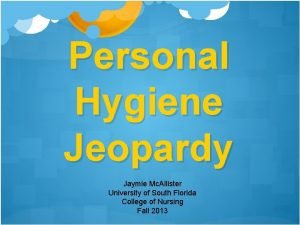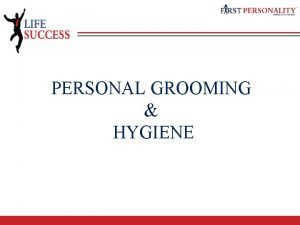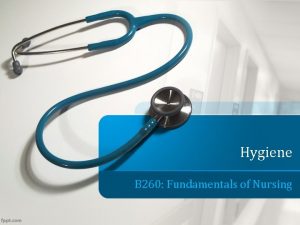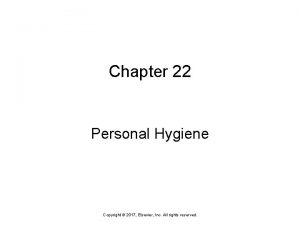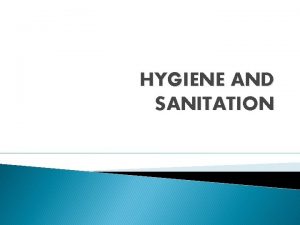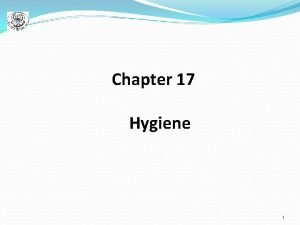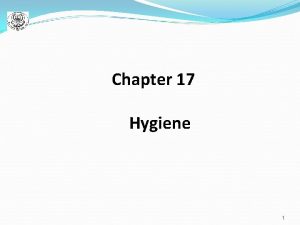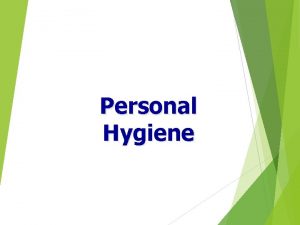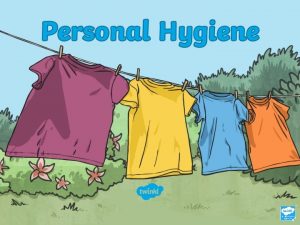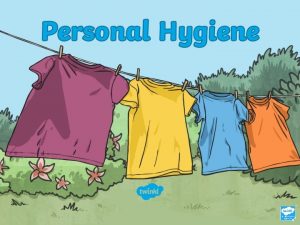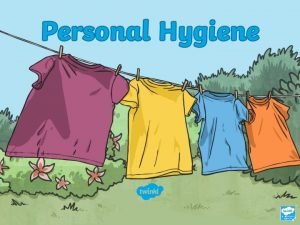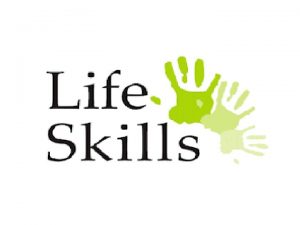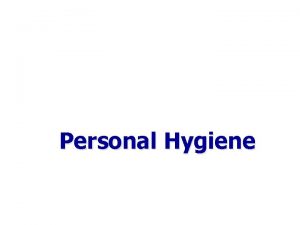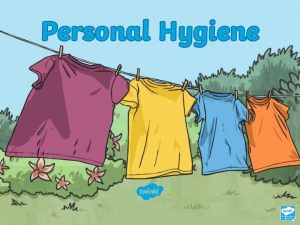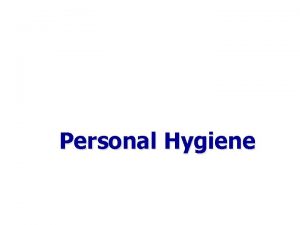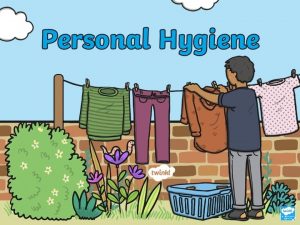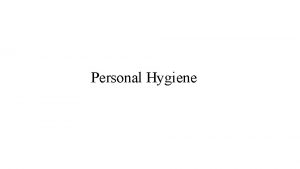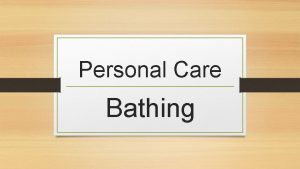Hygiene Hygiene practices that promote health through personal



















- Slides: 19

Hygiene

Hygiene: practices that promote health through personal cleanliness Activities that foster hygiene: 1. Bathing; cleaning and maintaining fingernails and toenails 2. Performing oral care

Integumentary System Most hygiene practices are based on maintaining or restoring a healthy intguementary system. Integumentary System Components 1. Skin 2. Mucous membrane 3. Hair 4. Fingernails, toenails 5. Teeth

Skin 1. Epidermis 2. Dermis 3. Subcutaneous layer

Mucous Membrane Line body passages such as the digestive, respiratory, urinary, and reproductive systems Mucous membrane also lines the conjunctiva of the eye a slimy substance that keeps the membranes soft and moist

Hair Made up of keratin Forms from cells at the base of a single follicle Helps to prevent heat loss Sebaceous glands in the hair follicles release sebum, an oily secretion

Nails Fingernails and toenails are made of keratin, which in concentrated amounts gives them their tough texture Normal nails are thin, pink, and smooth Fingernails and toenails provide some protection to the digits

Teeth Present beneath the gums at birth Contain the outer covering, enamel, a keratin structure Exposed portion of each tooth: crown Portion within the gum: root Adults: 28 to 32 permanent teeth Saliva: keeps the teeth clean and inhibits bacterial growth

Common Dental Problems Sugar, plaque, and bacteria may eventually erode the tooth enamel, causing caries Tartar leads to gingivitis while gum inflammation may cause periodontal disease

Hygiene practices Bathing Uses a cleansing agent such as soap and water to remove sweat, oil, dirt, and microorganisms from the skin Advantages of bathing 1. Eliminates body odor. 2. reduces the potential for infection 3. Stimulates circulation. 4. provides a refreshed and relaxed feeling. 5. improves self-image

Types of Bathing according to hygiene purposes 1. Tub bath or shower: There is no contraindication 2. Partial bathing: washing only those body areas subject to greatest soiling or that are sources of body odor. 3. For those who are independent persons 1. Bed bath( washing with a basin of water at the bedside) 2. Towel bath : The nurse uses a single large towel to cover and wash a client 3. Bag bath : disposable cloths in a plastic bag or container

Types of Bathing according to function 1. Sitz bath: Immersion of buttocks and perineum in a small basin of continuously circulating water (as in case of piles or episiotomy ) purposes: 1. Remove blood , serum, stool or urine 2. Reduce local swelling. 3. Relieves discomfort.

Types of Bathing according to function (cont’d) 2. Sponge bath: application of tipped water to the skin. purposes: 1. Reduces a fever. 3. Medicated bath: soaking or immersing in a mixture of water and another substance, such as (sodium bicarbonate) purposes: 1. Relieve itching or rashes

Types of Bathing according to function (cont’d) 4. Whirlpool bath: warm water that is continuously agitated within a tub or tank purposes: 1. Improve circulation. 2. Increase joint mobility. 3. Remove dead tissue 4. Relieve discomfort.

Shaving Removes unwanted body hair Accomplished with an electric or a safety razor Use of safety razor is contraindicated for those clients: 1. Receiving anticoagulant. 2. Receiving thrombolytic agents. 3. Taking high doses of aspirin. 4. With blood disorders as hemophilia. 5. With liver disease who have impaired clotting. 6. With rashes or inflamed skin. 7. Who are suicidal. For those we use an electric or battery–operated razor

Oral Hygiene Brushing and flossing the teeth Dentures and bridges require special cleaning and care Oral hygiene in unconscious clients whom need oral care more frequently than conscious clients Prevents aspiration of oral hygiene products and water

Hair Care Apply a conditioner to loosen tangles Use oil on the hair if it is dry Braid the hair to help prevent tangles Brush the hair slowly to increase circulation of sebum Use a wide-toothed comb, combing from end to crown Use shampoo to clean hair

Nail Care Keeping the fingernails and toenails clean and trimmed Nail care should be provided with extreme caution for the following clients: Clients with diabetes Clients with impaired circulation Client with thick nails

Visual and Hearing Devices Eyeglasses and hearing aids improve communication and socialization Eyeglasses Contact lenses Artificial eyes Hearing aids Infrared listening devices Examples of Hearing Aids In the ear Behind the ear Remote controlled
 Promote personal growth
Promote personal growth What is fcclas tagline
What is fcclas tagline Protect, promote, and improve the health of all people
Protect, promote, and improve the health of all people Ngoại tâm thu thất chùm đôi
Ngoại tâm thu thất chùm đôi Block nhĩ thất độ 2 type 1
Block nhĩ thất độ 2 type 1 Thể thơ truyền thống
Thể thơ truyền thống Thơ thất ngôn tứ tuyệt đường luật
Thơ thất ngôn tứ tuyệt đường luật Walmart thất bại ở nhật
Walmart thất bại ở nhật Tìm độ lớn thật của tam giác abc
Tìm độ lớn thật của tam giác abc Hãy nói thật ít để làm được nhiều
Hãy nói thật ít để làm được nhiều Tôn thất thuyết là ai
Tôn thất thuyết là ai Gây tê cơ vuông thắt lưng
Gây tê cơ vuông thắt lưng Sau thất bại ở hồ điển triệt
Sau thất bại ở hồ điển triệt Hygiene jeopardy
Hygiene jeopardy Importance of health and hygiene
Importance of health and hygiene Personal hygiene in catering
Personal hygiene in catering Circumcised vs uncircumcised cartoon
Circumcised vs uncircumcised cartoon Chapter 22 personal hygiene
Chapter 22 personal hygiene Personal hygiene objectives
Personal hygiene objectives Personal hygiene definition
Personal hygiene definition













